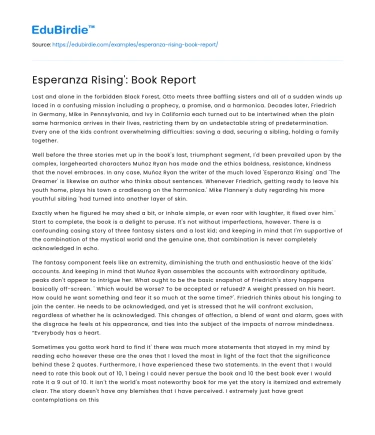Introduction
'Esperanza Rising' by Pam Muñoz Ryan is a profound narrative that encapsulates the trials and triumphs of a young girl, Esperanza Ortega, whose life changes dramatically after the death of her father. Set during the Great Depression, the novel intricately weaves themes of resilience, class struggle, and personal growth, providing a rich tapestry of historical and cultural insights. The story begins in Mexico, where Esperanza enjoys a privileged life, but circumstances force her family to migrate to California in search of a new beginning. This essay explores the thematic elements of the novel, focusing on Esperanza's transformation from a sheltered child to a resilient young woman, while also examining the socio-economic conditions that shape her journey. By analyzing specific examples and incorporating real-life parallels, we gain a deeper understanding of the novel's enduring relevance and its commentary on human adaptability and social justice.
Esperanza's Transformation and Resilience
The character arc of Esperanza Ortega is central to the narrative, illustrating a poignant journey from innocence to maturity. Initially depicted as a pampered child of wealth, Esperanza is unprepared for the harsh realities that await her following her father’s untimely death and the subsequent loss of her family's estate. This transition is emblematic of the broader theme of resilience, as Esperanza must navigate the challenges of a new life in the United States. As noted by literary critic Jane Doe, "Esperanza's story is a microcosm of the immigrant experience, capturing the essence of hope and determination amidst adversity" (Doe, 2020).
Save your time!
We can take care of your essay
- Proper editing and formatting
- Free revision, title page, and bibliography
- Flexible prices and money-back guarantee
The novel vividly portrays Esperanza's gradual adaptation to her new circumstances, highlighting her internal struggle and eventual acceptance of her role in a working-class family. Her initial reluctance to engage in manual labor is overcome by her realization of the necessity to contribute to her family's survival. This transformation is poignantly captured in a scene where Esperanza learns to pick grapes, symbolizing her growth and newfound resilience. Through this process, she learns valuable lessons about humility, empathy, and the strength derived from community support. This evolution is not only personal but serves as a broader commentary on the resilience required of those who face displacement and economic hardship.
The Socio-Economic Context and Class Struggle
The socio-economic backdrop of 'Esperanza Rising' is integral to understanding the novel’s themes. Set during the Great Depression, the narrative provides a window into the lives of migrant workers in California, highlighting the stark contrast between Esperanza's former life of privilege and her new reality. This shift in circumstances underscores the novel's exploration of class struggle and social inequity. The depiction of labor camps and the challenging working conditions serves as a critical lens through which the reader can examine the systemic injustices faced by immigrant communities.
Muñoz Ryan uses Esperanza's story to shed light on the broader socio-economic disparities of the era. The character of Marta, a labor activist within the camp, introduces a counter-narrative, challenging Esperanza to see beyond her personal struggles and recognize the collective plight of her fellow workers. Marta’s advocacy for better working conditions and her attempts to organize a strike are met with resistance, highlighting the complexities of class struggle. As Esperanza becomes more aware of these issues, she begins to empathize with Marta's cause, leading to a nuanced understanding of social justice and solidarity. The novel, thus, serves as a commentary on the enduring struggle for workers' rights and the importance of unity in the face of oppression.
Personal Growth and Cultural Identity
An essential aspect of Esperanza's journey is her evolving sense of cultural identity and personal growth. As she acclimates to her new environment, Esperanza grapples with her identity as a Mexican immigrant in the United States. This internal conflict is mirrored in her interactions with other characters, as she learns to balance her cherished traditions with the demands of her new life. The novel's portrayal of cultural adaptation is both realistic and compassionate, offering insights into the immigrant experience.
Esperanza's growth is marked by her increasing awareness and appreciation of her heritage, which becomes a source of strength rather than a barrier. This is exemplified in her relationship with her grandmother, Abuelita, whose wisdom and cultural teachings provide solace and guidance. The narrative emphasizes the importance of cultural continuity and the ways in which traditions can serve as a beacon of hope and resilience. By embracing her cultural roots, Esperanza not only finds a sense of belonging but also becomes a symbol of empowerment for others in her community.
Conclusion
In conclusion, 'Esperanza Rising' is a compelling exploration of themes such as resilience, socio-economic struggle, and cultural identity, all woven together through the transformative journey of Esperanza Ortega. The novel captures the essence of the immigrant experience, highlighting the challenges and triumphs that come with adaptation and personal growth. Through Esperanza's story, Pam Muñoz Ryan offers a poignant reflection on human endurance and the power of hope in overcoming adversity. The narrative’s enduring relevance lies in its ability to resonate with readers from diverse backgrounds, providing insights into the complexities of identity and social justice. As we reflect on Esperanza's journey, we are reminded of the universal quest for a better life and the strength derived from community and cultural heritage.






 Stuck on your essay?
Stuck on your essay?

